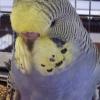Dietary iodine for budgerigars
Where do I start?
Iodine is an important part of any bird's diet and a deficiency in this vital nutrient can lead to serious health problems.
Unfortunately budgerigars are much more susceptible to iodine deficiency than most other aviary birds and need higher levels to keep them in peak condition.
Iodine is needed for normal functioning of the thyroid gland. Hormones produced by the thyroid are vital in controlling the metabolism of the body and help regulate many functions in the body including growth, digestion, heart rate, body temperature, the nervous system and the reproductive system.
Symptoms of iodine deficiency . . .
Iodine deficiency leads to a decreased production of thyroid hormone and the body responds by increasing the release of Thyroid Stimulating Hormone (TSH). This in turn causes enlargement of the thyroid gland.
The main sign of iodine deficiency in budgerigars is difficulty in breathing, caused by pressure of the oversized thyroid on the trachea (windpipe). The affected bird typically develops a "clicking" noise or audible whistling or squeak as it breathes. If left untreated it can lead to death by suffocation.
In domestic poultry, iodine deficiency in breeding hens results in reduced egg iodine levels, reduced egg production, decreased hatchability, prolonged hatching time, and thyroid enlargement in the embryos.
Since a deficiency of iodine will decrease breeding performance, some budgerigar breeders use iodine supplements to enhance the metabolism of budgerigars and stimulate the birds to breed, to accelerate the moult of young birds and to ensure birds are at their peak for showing.
Prevalence of iodine deficiency . . .
Iodine deficiency tends to be a regional problem as natural exposure to iodine is greater in coastal areas. Although wild budgerigars predominantly inhabit inland areas of Australia (and eat a diet based on seeds from a wide variety of species of ground plants) they are thought to balance their diet by foraging in dirt and river edges in search of minerals and trace elements.
Pet budgerigars are thought to be at increased risk of iodine deficiency due to their natural reluctance to supplement their diets with additional foodstuffs, particularly when fed on seed-based diets. The iodine content of the various seeds fed to budgerigars varies with the climate and location where they are grown. Australian birdseeds tend to be naturally low in iodine, although marked regional variations occur due to differing soil types and salt deposits.
Until the 1960s, symptoms of iodine deficiency were commonly seen in domesticated budgerigars fed on all-seed diets. The WALTHAM Centre for Pet Nutrition (WCPN) was responsible for establishing the incidence of iodine deficiency in budgerigars, where researchers found that 85 percent of budgerigars suffered from thyroid disease and 24 percent died as a result.
In light of the fact that seed-based diets may be deficient not only in iodine, but in a number of other vital nutrients, responsible birdseed companies supplement their seed mixes to increase the levels of certain minerals and vitamins. For example GOLDEN COB Budgerigar diets are supplemented with a number of essential vitamins and minerals, including iodine.
Treating iodine deficiency
Treatment for iodine deficiency should only be carried out on the advice of your veterinarian. The usual program consists of a drop of iodine put into the drinking water daily for two weeks, then once a week thereafter. This should continue for at least eight weeks.
Iodine toxicity . . .
Excess iodine can be just as harmful as a deficiency and interferes with normal thyroid gland function - particularly in young birds.
Iodine toxicity is rare in birds and animals since it requires a regular elevated intake of iodine and is most likely to occur in an aviary through misuse of disinfectants containing iodine or over-zealous use of iodine supplements.
The safe upper limit for iodine in poultry food has been set at 10mg/kg by EU legislation. The concentration of iodine in the TRILL budgerigar formulation exceeds the minimum requirements established by the WCPN and is below the EU safe upper limit for poultry.
Iodine toxicity has not been well defined in caged birds, but has been observed in poultry fed a ration with an iodine content of 625mg/kg. Broiler chickens showed signs of iodine toxicity, including poor growth and reduced food intake, when fed a diet containing 900 or 1,200mg/kg iodine for nine to 13 days. Excess iodine in grower diets can prevent sexual maturation in male and female fowl.
In breeding poultry, fertility of female breeders is unaffected by high iodine intake, but hatching of fertile eggs is reduced, hatching time is extended and embryonic mortality and dead-in-shell proportions are increased.
In contrast, male fertility is decreased because of an increased incidence of dead spermatozoa, although hatchability of eggs from normally fed hens is unaffected. All reproductive variables, together with feed intake and body weight, have been shown to return to normal within seven days of feeding a diet with normal iodine levels.


